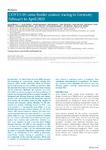COVID-19: cross-border contact tracing in Germany, February to April 2020
Markus, Inessa
Steffen, Gyde
Lachmann, Raskit
Marquis, Adine
Schneider, Timm
Tomczyk, Sara
Koppe, Uwe
Rohde, Anna M.
Schink, Susanne Barbara
Seifried, Janna
Domaszewska, Teresa
Rexroth, Ute
an der Heiden, Maria
Since January 2020, severe acute respiratory syndrome coronavirus 2 (SARS-CoV-2) has rapidly spread to become a global pandemic [1]. Active case finding, early detection and isolation of cases and their contacts are essential for breaking transmission chains. A modelling study showed that 70% of contacts should be traced in order to control the outbreak, assuming a baseline reproduction rate of 2.5 [2].
Early warning systems for the serious cross-border spread of infectious pathogens include the International Health Regulations (IHR) 2005 and the Early Warning and Response System (EWRS) for the European Union/European Economic Area (EU/EEA) countries [3,4]. Within Germany, communication channels have been established in accordance with the German Infection Protection Act (Infektionsschutzgesetz; IfSG). Cross-border contact tracing at the national level is operated by the Robert Koch Institute (RKI), the federal public health institute in Germany.
The first cases of coronavirus disease 2019 (COVID-19) in Germany occurred in Bavaria at the end of January 2020 [5]. The first SARS-CoV-2 cluster also led to cross-border contacts and exposures on flights since close contacts and suspected cases travelled to Austria and Spain after exposure. This required intensive international communication to identify and share the information on contacts with the responsible health authorities. An international communication and contact tracing team (RKI IC-Team) was rapidly created in the RKI COVID-19 Emergency Operations Centre (EOC) including members of all units of the department for infectious disease epidemiology and other departments at the RKI. The core task of the team was to collect and communicate information on confirmed COVID-19 cases and their contacts to other countries in the event of cross-border relevance. In addition, incoming information on German citizens exposed abroad was communicated through the federal state health authorities to the responsible local health authorities in Germany.
The spread of SARS-CoV-2 in Germany triggered the introduction of various measures: (i) mass gatherings with more than 1,000 participants were banned after calendar week 10, (ii) schools and public places were closed in several federal states, (iii) physical distancing measures of at least 1.5 m to another person were recommended, (iv) it was recommended to cancel non-essential travel and (v) quarantine measures for travellers from high risk areas entering Germany were introduced in calendar week 15. Because of the federal structure in Germany, the measures and their implementation varied between the states.
This work aimed to describe the extent and course of activities resulting from information on COVID-19 exposure events with a cross-border context. Further, we discuss the challenges experienced and possible workflow improvements.
Dateien zu dieser Publikation

